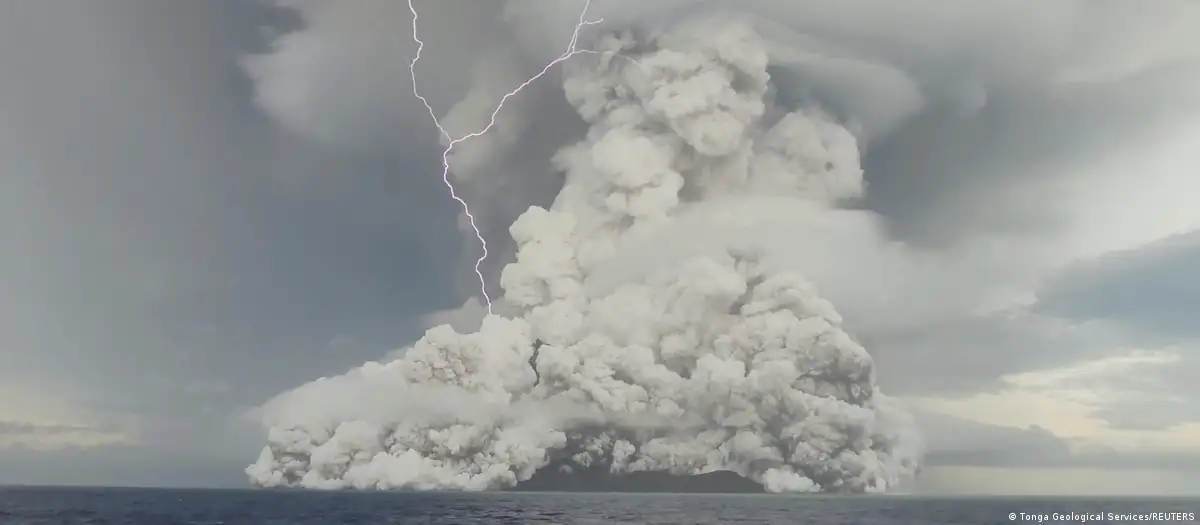From NIWA
NIWA and the UK’s National Oceanography Centre (NOC) say that the flows travelled at speeds of up to 122km/hour – up to 50% faster than any other recorded.
This new analysis, made possible by the NIWA-Nippon Foundation Tonga Eruption Seabed Mapping Project (TESMaP), comes after earlier results showed the eruption of Hunga Tonga–Hunga Ha’apai remobilised a staggering 10km3 of material from the seafloor.
As material from the volcanic eruption collapsed into the ocean, this triggered a huge surge of rock, ash, and gas that caused extensive damage to Tonga’s underwater telecommunication cables some 80km away.
Dr Emily Lane is NIWA’s Principal Scientist for Natural Hazards and is a co-author on the paper. She said the timings and locations of the damage to two subsea cables allowed them to determine the speeds of flows.
“Just a few months after the eruption, our team set sail to find out what caused it and what the impacts were. Surveys showed that Tonga’s domestic cable was buried under 30m of material, which we sampled and confirmed as containing deposits formed by a powerful seafloor flow triggered by the eruption.
“What’s impressive is that Tonga’s international cable lies in a seafloor valley south of the volcano, meaning the flow had enough power to go uphill over huge ridges, and then back down again,” said Dr Lane.
Kevin Mackay is a NIWA marine geologist and voyage leader of TESMaP. He says that this is just another record ticked off the list for this astonishing event.
“The seafloor flows were one of the big unknowns from this eruption – with it being an underwater volcano, it’s something you rarely get to study just after the fact. With atmospheric pressure waves circling the globe multiple times, and it being the largest atmospheric explosion on Earth in over 100 years, this just adds to that impressive list,” said Mr Mackay.
Dr Isobel Yeo is a volcanologist at the National Oceanography Centre (NOC) and joint-lead scientist on the paper. She said this work is helping us to better understand the hazards of submerged volcanoes worldwide.
“A huge number of the world’s volcanoes lie under the ocean, yet only a handful of those are monitored. As a result, the risk posed to coastal communities and critical infrastructure remains poorly understood, and more monitoring is urgently needed,” said Dr Yeo.
“The seafloor flows were one of the big unknowns from this eruption – with it being an underwater volcano, it’s something you rarely get to study just after the fact. With atmospheric pressure waves circling the globe multiple times, and it being the largest atmospheric explosion on Earth in over 100 years, this just adds to that impressive list,” said Mr Mackay.
Dr Isobel Yeo is a volcanologist at the National Oceanography Centre (NOC) and joint-lead scientist on the paper. She said this work is helping us to better understand the hazards of submerged volcanoes worldwide.
“A huge number of the world’s volcanoes lie under the ocean, yet only a handful of those are monitored. As a result, the risk posed to coastal communities and critical infrastructure remains poorly understood, and more monitoring is urgently needed,” said Dr Yeo.
Hunga-Tonga Hunga-Ha'apai: The highest eruption column ever recorded
image : Tonga Geological Services
image : Tonga Geological Services
Dr Mike Clare a geohazards researcher, also at NOC, said “Findings from this important study not only improve our understanding of one of the largest events on our planet, but are already being used by the subsea cable industry to design more resilient communications networks in volcanically active regions. Subsea cables are a critical part of all of our lives, so making sure global connections stay secure is important”.
The paper was part of a joint international project including NIWA, The Nippon Foundation, and the Natural Environment Research Council in collaboration with 13 partners from Tonga, New Zealand, Australia, Germany, USA, and the UK.
The paper was part of a joint international project including NIWA, The Nippon Foundation, and the Natural Environment Research Council in collaboration with 13 partners from Tonga, New Zealand, Australia, Germany, USA, and the UK.
Links :


No comments:
Post a Comment